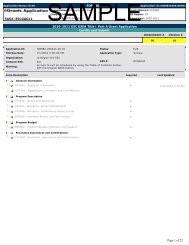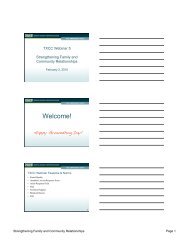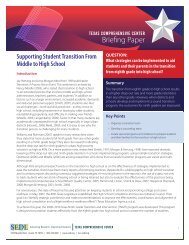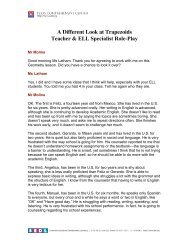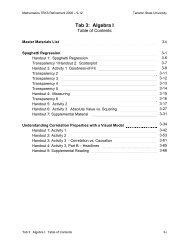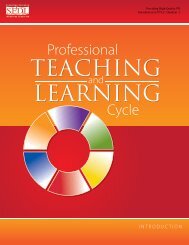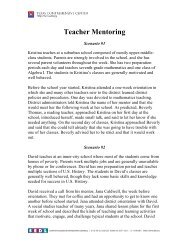The Professional Teaching and Learning Cycle: Introduction - Texas ...
The Professional Teaching and Learning Cycle: Introduction - Texas ...
The Professional Teaching and Learning Cycle: Introduction - Texas ...
You also want an ePaper? Increase the reach of your titles
YUMPU automatically turns print PDFs into web optimized ePapers that Google loves.
<strong>Professional</strong> <strong>Teaching</strong> <strong>and</strong> <strong>Learning</strong> <strong>Cycle</strong><br />
SEDL<br />
Step 3: Plan<br />
Planning teams, working together, formally develop a common lesson incorporating the<br />
selected strategies <strong>and</strong> agree on the type of student work each teacher will use later (in Step V:<br />
Analyze) as evidence of student learning. Teachers working collaboratively<br />
• develop a common formal plan outlining the lesson objectives (relevant to the<br />
st<strong>and</strong>ards), the materials to be used, the procedures, the time frame for the lesson,<br />
<strong>and</strong> the activities in which students will be engaged <strong>and</strong><br />
• decide what evidence of student learning will be collected during the<br />
implementation.<br />
Step 4: Implement<br />
Teachers carry out the planned lesson, make note of implementation successes <strong>and</strong> challenges,<br />
<strong>and</strong> gather the agreed-upon evidence of student learning. Teachers working collaboratively<br />
• deliver the lesson as planned within the specified time period;<br />
• record results, especially noting where students struggled <strong>and</strong>/or where instruction<br />
did not achieve expected outcomes; <strong>and</strong><br />
• collect the agreed-upon evidence of student learning to take back to the collaborative<br />
Step 5: Analyze<br />
planning team.<br />
Teachers gather again in collaborative teams to examine student work <strong>and</strong> discuss student<br />
underst<strong>and</strong>ing of the st<strong>and</strong>ards. Teachers working collaboratively<br />
• revisit <strong>and</strong> familiarize themselves with the st<strong>and</strong>ards before analyzing student<br />
work;<br />
• analyze a sampling of student work for evidence of student learning;<br />
• discuss whether students have met the expectations outlined in the st<strong>and</strong>ards <strong>and</strong><br />
make inferences about the strengths, weaknesses, <strong>and</strong> implications of instruction;<br />
<strong>and</strong><br />
• identify what students know <strong>and</strong> what skills or knowledge needs to be strengthened<br />
Step 6: Adjust<br />
in future lessons.<br />
Collaborative teams reflect on the implications of the analysis of student work. Teachers discuss<br />
alternative instructional strategies or modifications to the original instructional strategy that<br />
may be better suited to promoting student learning. Teachers working collaboratively<br />
• reflect on their common or disparate teaching experiences;



